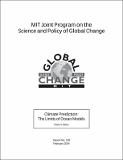Climate Prediction: The Limits of Ocean Models
Author(s)
Stone, Peter H.
DownloadMITJPSPGC_Rpt106.pdf (406.8Kb)
Metadata
Show full item recordAbstract
We identify three major areas of ignorance which limit predictability in current ocean GCMs. One is the very crude representation of subgrid-scale mixing processes. These processes are parameterized with coefficients whose values and variations in space and time are poorly known. A second problem derives from the fact that ocean models generally contain multiple equilibria and bifurcations, but there is no agreement as to where the current ocean sits with respect to the bifurcations. A third problem arises from the fact that ocean circulations are highly nonlinear, but only weakly dissipative, and therefore are potentially chaotic. The few studies that have looked at this kind of behavior have not answered fundamental questions, such as what are the major sources of error growth in model projections, and how large is the chaotic behavior relative to realistic changes in climate forcings. Advances in computers will help alleviate some of these problems, for example by making it more practical to explore to what extent the evolution of the oceans is chaotic. However models will have to rely on parameterizations of key small-scale processes such as diapycnal mixing for a long time. To make more immediate progress here requires the development of physically based prognostic parameterizations and coupling the mixing to its energy sources. Another possibly fruitful area of investigation is the use of paleoclimate data on changes in the ocean circulation to constrain more tightly the stability characteristics of the ocean circulation.
Description
Abstract in HTML and technical report in PDF available on the Massachusetts Institute of Technology Joint Program on the Science and Policy of Global Change website (http://mit.edu/globalchange/www/).
Date issued
2004-02Publisher
MIT Joint Program on the Science and Policy of Global Change
Citation
Report no. 106
Series/Report no.
Report no. 106;